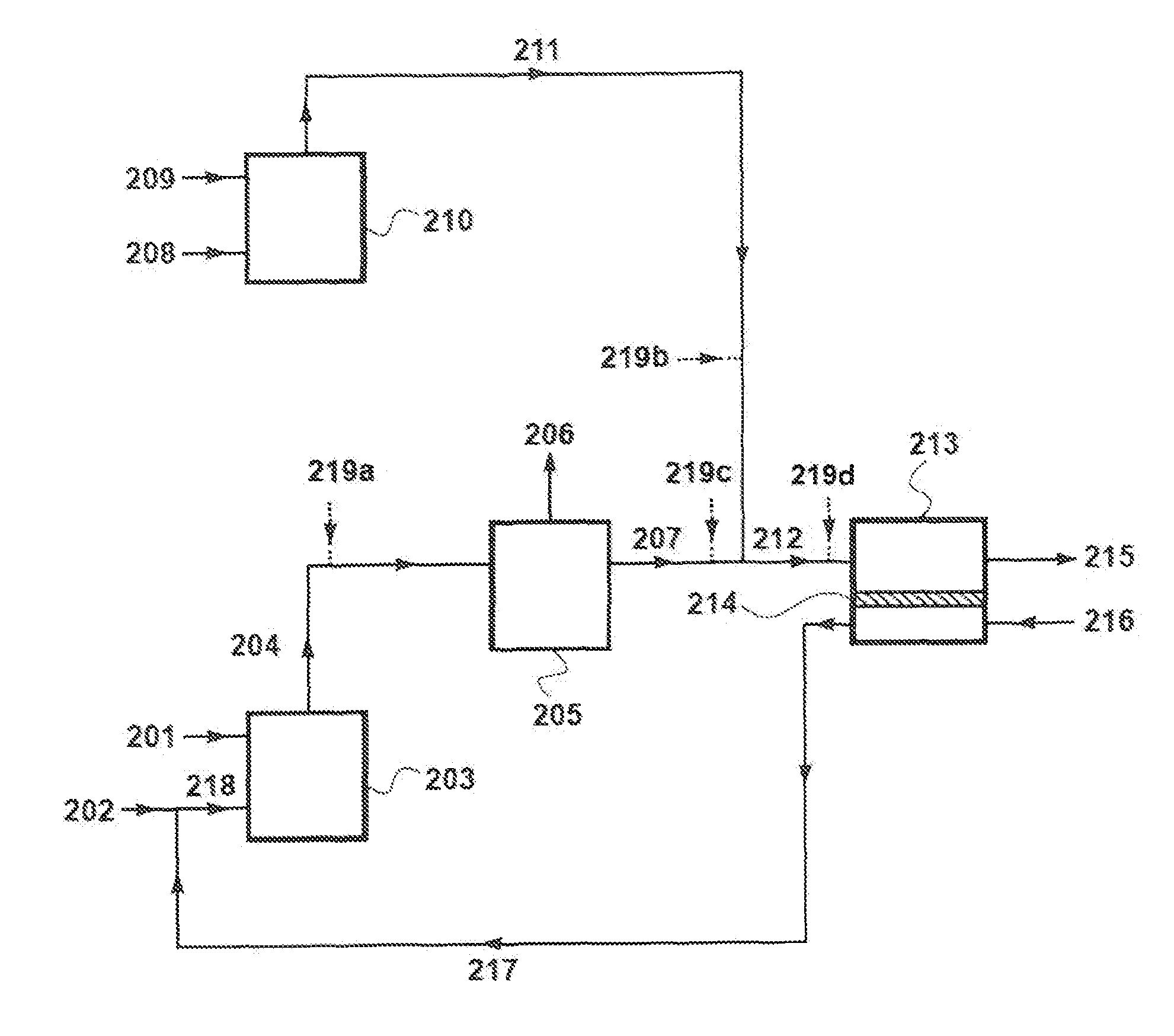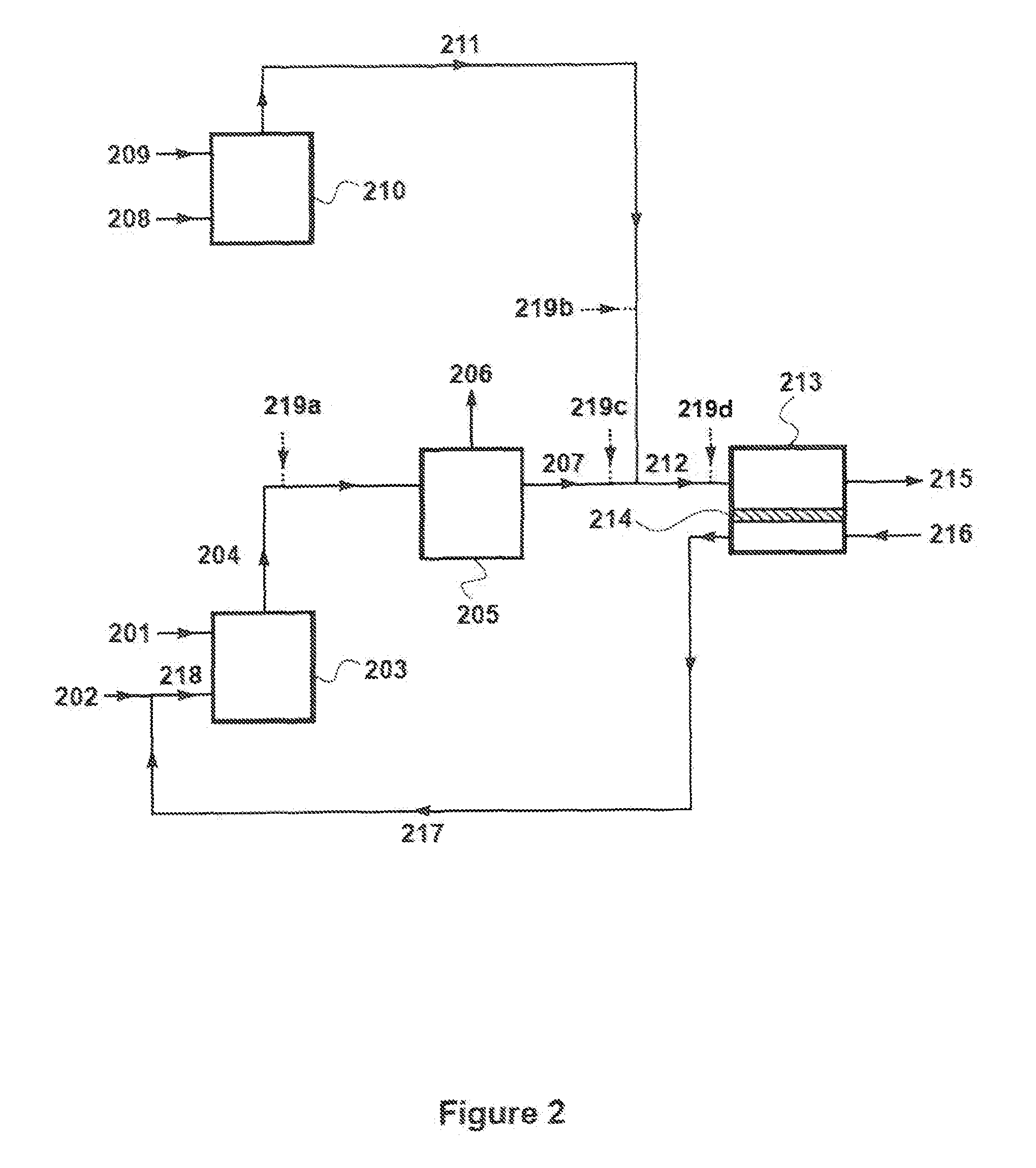Sweep-based membrane separation process for removing carbon dioxide from exhaust gases generated by multiple combustion sources
a technology of exhaust gas and membrane separation, which is applied in the direction of separation process, emission prevention, combustion types, etc., can solve the problems of increasing the cost of capital investment, affecting the environmental protection of the environment,
- Summary
- Abstract
- Description
- Claims
- Application Information
AI Technical Summary
Benefits of technology
Problems solved by technology
Method used
Image
Examples
example 1
Combustion Process with No Carbon Capture or Sweep-Based Membrane Separation (not in Accordance with the Invention)
[0151]As a comparative example, a computer calculation was performed to determine the chemical composition of untreated exhaust gas from a steam boiler. The exhaust gas was cooled to 30° C. at atmospheric pressure to remove some of the water vapor, which was then emitted into the atmosphere. Results are shown in Table 1.
[0152]
TABLE 1Exhaust GasCondensedCooled Gas Streamfrom BoilerWater VaporExhaust GasTotal Flow6,5807745,800(m3 / h)Pressure1.01.01.0(bara)Temp (° C.)1804040Component (mol %)H2O15.599.94.2N272.9—82.5O23.9—4.4CO27.7—8.8
[0153]One boiler emits about 1 ton / h of carbon dioxide (2 ton / h of carbon dioxide for two boilers). The cooled exhaust gas has a concentration of about 8.8 mol % carbon dioxide.
example 2
Combustion Process with Sweep-Based Membrane Separation According to FIG. 1 (not in Accordance with the Invention)
[0154]A computer calculation was performed to determine the composition of the process streams from just one boiler. Because the boiler exhausts were treated separately, two capture systems were needed, one for each boiler.
[0155]Prior to the carbon capture step, the exhaust stream, 104, is cooled and pressurized from 1.0 to 1.1 bara with a blower to circulate the gas through the process (not shown in the figure).
[0156]The results of the calculation are show in Table 2.
[0157]
TABLE 2BoilerCO2Off-VentPermeateExhaustConcentrateGasGasStreamGas Stream(104)(106)(107)(110)(112)Total Flow8,0603327,7306,2408,490(m3 / h)Pressure1.10.21.11.00.9(bara)Temp (° C.)4040403040Component (mol %)H2O42.215.83.70.53.0N271.419.673.681.667.8O23.21.73.27.115.0CO221.263.019.44.814.2
[0158]The calculated membrane area and net energy required for one of the two boiler capture units employed were as fol...
example 3
Combustion Process with Sweep-Based Membrane Separation According to FIG. 2
[0162]A calculation was performed to illustrate the treatment of exhaust gases from two boilers using a single capture unit as illustrated in FIG. 2. The results of the calculation are shown in Table 3.
[0163]
TABLE 3FirstCO2SecondMixedPermeateExhaustConcentrateOff-gasExhaustGasVent GasStreamGas Stream(204)(206)(207)(211)(212)(215)(217)Total flow (m3 / h)8,0107607,2505,93013,19011,9108,490Pressure (bara)1.10.21.11.11.11.00.9Temp (° C.)40404045423542Component (mol %)H2O4.215.53.13.93.41.23.6N275.228.180.182.781.387.370.9O23.22.23.34.84.06.415.0CO217.454.213.68.611.35.110.5
[0164]Compared Example 2, the total membrane area required for this process is reduced by 27% to 7,250 m2 per ton of carbon dioxide separated. The energy consumption is also reduced to 175 kW per ton of carbon dioxide separated.
[0165]The concentrated carbon dioxide stream, 206, is enriched in carbon dioxide to a concentration of 54 mol % carbon d...
PUM
| Property | Measurement | Unit |
|---|---|---|
| pressure | aaaaa | aaaaa |
| permeable | aaaaa | aaaaa |
| adsorption | aaaaa | aaaaa |
Abstract
Description
Claims
Application Information
 Login to View More
Login to View More - R&D
- Intellectual Property
- Life Sciences
- Materials
- Tech Scout
- Unparalleled Data Quality
- Higher Quality Content
- 60% Fewer Hallucinations
Browse by: Latest US Patents, China's latest patents, Technical Efficacy Thesaurus, Application Domain, Technology Topic, Popular Technical Reports.
© 2025 PatSnap. All rights reserved.Legal|Privacy policy|Modern Slavery Act Transparency Statement|Sitemap|About US| Contact US: help@patsnap.com



